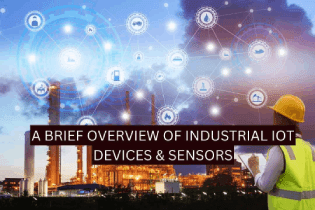The Industrial Internet of Things (IoT) refers to the integration of IoT technology in industrial systems and processes to improve efficiency, safety, and productivity. It involves connecting a wide range of industrial iot devices and sensors to the internet and using data from these connected devices/machines to make informed decisions.
Some common IoT devices in the industrial sector include:
- Smart sensors and actuators: used to monitor and control physical conditions such as temperature, pressure, and vibration in industrial environments
- Industrial gateways: act as a bridge between field devices and the cloud or control systems
- Robotics and automation systems: use IoT technology to improve efficiency and performance
- Industrial cameras: used for remote monitoring and inspection purposes
- Industrial wearables: used to improve worker safety and efficiency in industrial settings
- Smart machines: such as 3D printers, CNC machines, and other industrial machines equipped with sensors and connected to the internet.
Sensors that are commonly used in industrial IoT include:
- Temperature sensors: used to measure temperature in industrial processes and environments
- Pressure sensors: used to measure pressure in fluid systems, gases, and liquids
- Humidity sensors: used to measure the amount of moisture in the air
- Vibration sensors: used to detect mechanical vibrations and wear in machinery
- Light sensors: used to measure light intensity and detect changes in illumination
- Flow sensors: used to measure fluid flow in pipelines and ducts
- Gas sensors: used to detect the presence and concentration of gases in the air
- Proximity sensors: used to detect the presence of objects or changes in the distance between objects
Introducing Syncross IIoT
- Real-time monitoring: Syncross IIoT allows you to monitor your equipment and processes in real time. This can help you identify potential issues before they become major problems, allowing you to proactively address them.
- Energy management: Syncross IIoT can optimize energy usage in industrial processes and reduce energy costs
- Utility Management: Syncross IIoT can give the overview of consumption utilities such as water, gas, compressed air, etc. to reduce wastage
- Predictive maintenance: Syncross IIoT can also enable predictive maintenance by using machine learning algorithms to detect patterns and anomalies in your equipment’s performance. This can help you schedule maintenance activities in advance, minimizing unplanned downtime and reducing maintenance costs.
- Remote access and control: Syncross IIoT allows you to remotely access and control your equipment and processes, providing you with greater flexibility and control. This can be particularly useful if you have multiple sites or if you need to access equipment in hard-to-reach locations.
- Enhanced safety and security: Syncross IIoT can help you improve safety and security in your workplace by providing real-time data on potential hazards or security breaches. This can help you take preventative measures to protect your employees, equipment, and assets.
- Data analytics and insights: Syncross IIoT can also enable you to gather and analyze data from your equipment and processes, providing you with valuable insights that can inform decision-making. By collecting and analyzing data on equipment performance, you can optimize processes, reduce waste, and improve overall efficiency.
Overall, Syncross IIoT can help you streamline your operations, reduce costs, and improve performance, ultimately leading to increased profitability and business growth.

